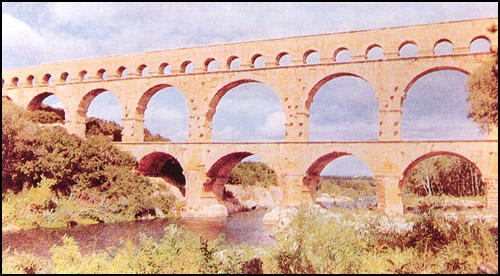Roman Aqueducts
In the early days of Rome the city got its water from wells, local springs and the River Tiber. However, as the population grew it became clear that Rome would have to find another way of supplying its people with water.
A Roman called Appius Claudius was given the task of solving this problem. He eventually came up with the aqueduct system. It was not an original idea and was in fact based on a system used by Greeks living in southern Italy.
There were several problems with the first aqueduct built in 312 BC, but over the years Roman engineers were able to perfect the system. By the first century AD Rome had nine aqueducts bringing in millions of gallons of water every day.
The Romans built aqueducts all over their empire. One of the most impressive was the Zaghouan to Carthage aqueduct built in the second century AD. A large reservoir was built in the Zaghouan mountains and was connected to Carthage by a 80 kilometre pipeline.

When it was decided that a new aqueduct was needed, surveyors were sent out to search for a possible water source. As the aqueduct had to be built with a constant downward slope from beginning to end (the Romans aimed at a gradient of about one foot per mile), the water source had to be much higher than the place it was supplying. An ideal source would be a large mountain lake.
Before building the aqueduct, engineers had to decide on the best route for the pipeline. Sometimes this meant building a tunnel through a hill, while on other occasions the pipeline made diversions.
Inside the town or city, one or more large reservoirs would be built into which the water would go before being distributed. Each reservoir would be connected to three pipes. The first pipe ran to another tank that supplied the homes of the wealthy people. The other two pipes led to street fountains and public baths.
The reason for these three pipes was that it enabled the authorities to ration water when needed. For example, in times of shortage the water fountains would be the last to be turned off.
Primary Sources
(1) Vitruvius, On Architecture (c. AD 10)
Before we begin to lay the water on, we study the bodies of those who live in the neighbourhood. If they are strong, of clear complexion, free from inflamed eyes, the water will pass... Water is much more wholesome from earthenware pipes than from lead pipes. For it seems that lead is harmful to the human body. For example, workers in lead have poor complexions.
(2) Pliny the Elder, Natural History (c. AD 75)
All previous aqueducts have been completely outclassed by the lavish schemes begun by the Emperor Caligula... 350 million sesterces were expended on this project. If we take careful account of all the abundant supply of water for public buildings, baths, settling-tanks, pools, private mansions, gardens, and country estates close to the city, and the distance the water travels before entering the city, the height of the arches, the tunnelling of mountains, the levelling of routes across deep valleys, one must rate all this as the most remarkable achievement anywhere in the world.
(3) Juvenal described a meal given by his patron Virro in his Satire V (c. AD 110)
Look how Virro grumbles as he hands out the bread, although it's so hard you can scarcely break it, solidified lumps of old mouldy dough that crack your grinders... But the loaf reserved for my patron is snowy-white, fresh-baked from the very finest flour. And remember, please, to keep your hands to yourself, to show a proper respect for the bread-pan. Yet if by chance you reach for a slice, someone is bound to make you drop it at once: "Keep to your own basket if you please, learn the colour of your bread!"
Virro is served with a lamprey: no finer specimen ever came from Sicilian waters... But what is in store for you? An eel, perhaps (though it looks like a water-snake), or a grey-mottled river pike, born and bred in the Tiber, bloated with sewage, a regular visitor to the cesspool underlying the slums of Rome.
Questions
1. How did the Roman engineers make sure that the water supplied by the aqueducts was healthy to drink?
2. Explain why Pliny the Elder was so proud of the aqueduct system. Comment on the reliability and value of this source.
3. Give as many reasons as you can why the Romans had to start building aqueducts in the 4th century BC. Explain how these different reasons were connected.
